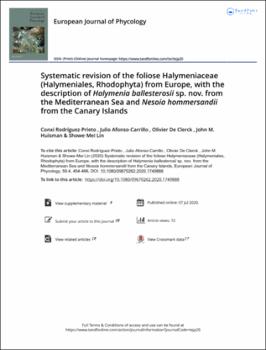Systematic revision of the foliose Halymeniaceae (Halymeniales, Rhodophyta) from Europe, with the description of Halymenia ballesterosii sp. nov. from the Mediterranean Sea and Nesoia hommersandii from the Canary Islands
Fecha
2020Resumen
In the past, large, foliose and unbranched Halymenia-like plants from Europe were often identified as ‘Halymenia latifolia’,
however recent taxonomic studies have shown that ‘H. latifolia’ was a catch-all name for at least three cryptic species:
Neofolia rosea, Nesoia mediterranea, and the genuine H. latifolia, which has been transferred to the recently established
genus Nesoia. In this study, we further refine the taxonomy of European Halymeniaceae by examining new collections of
foliose taxa from the Mediterranean Sea and Macaronesia. Analyses of rbcL gene sequences showed that unbranched foliose
Halymeniaceae from Europe can be separated into five species, including three previously described species in Neofolia
(N. rosea) and Nesoia (N. latifolia and N. mediterranea) and two new species belonging to Halymenia (H. ballesterosii sp.
nov.) and Nesoia (N. hommersandii sp. nov.). Halymenia ballesterosii is the only known unbranched foliose species in the
genus from Europe and can be separated from morphologically similar species in Neofolia and Nesoia by protruding surface
cells, two-celled carpogonial branches, a basal nutritive cell cluster in the carpogonial branch ampullae, and secondary
connecting filaments issued from basal cells of ampullar filaments. Nesoia hommersandii differs from N. latifolia by the lack
of swollen arms in medullary stellate cells and cystocarps that slightly protrude above the thallus surface. We expect that the
species diversity of foliose Halymeniaceae may increase when more foliose plants are collected and examined from different
locations in Europe.






